
A candle is an ignitable wick embedded in wax, or another flammable solid substance such as tallow, that provides light, and in some cases, a fragrance. A candle can also provide heat or a method of keeping time.

A kerosene lamp is a type of lighting device that uses kerosene as a fuel. Kerosene lamps have a wick or mantle as light source, protected by a glass chimney or globe; lamps may be used on a table, or hand-held lanterns may be used for portable lighting. Like oil lamps, they are useful for lighting without electricity, such as in regions without rural electrification, in electrified areas during power outages, at campsites, and on boats. There are three types of kerosene lamp: flat-wick, central-draught, and mantle lamp. Kerosene lanterns meant for portable use have a flat wick and are made in dead-flame, hot-blast, and cold-blast variants.

A lantern is an often portable source of lighting, typically featuring a protective enclosure for the light source – historically usually a candle or a wick in oil, and often a battery-powered light in modern times – to make it easier to carry and hang up, and make it more reliable outdoors or in drafty interiors. Lanterns may also be used for signaling, as torches, or as general light-sources outdoors.
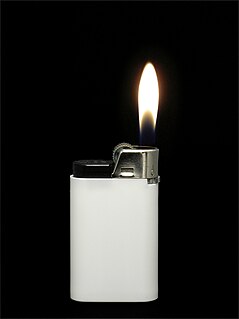
A lighter is a portable device which generates a flame, and can be used to ignite a variety of items, such as cigarettes, gas stoves, fireworks, candles or campfires. It consists of a metal or plastic container filled with a flammable liquid or compressed gas, a means of ignition to produce the flame, and some provision for extinguishing the flame. Alternatively, a lighter can be powered by electricity, using an electric arc or heating element to ignite the target.

Fire eating is the act of putting a flaming object into the mouth and extinguishing it. A fire eater can be an entertainer, a street performer, part of a sideshow or a circus act but has also been part of spiritual tradition in India.
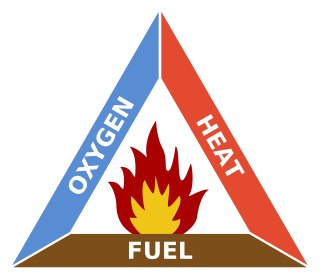
The fire triangle or combustion triangle is a simple model for understanding the necessary ingredients for most fires.
A driptorch is a tool used in wildfire suppression, controlled burning, and other forestry applications to intentionally ignite fires by dripping flaming fuel onto the ground.
This is a glossary of firefighting equipment.
The wick effect is the partial or total destruction of a human body by fire, when the clothing of the victim soaks up melted human fat and acts like the wick of a candle. The wick effect is a phenomenon that is found to occur under certain conditions, and has been thoroughly observed. It is one commonly offered explanation for the alleged phenomenon of spontaneous human combustion.
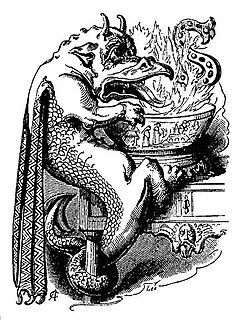
Snap-dragon was a parlour game popular from about the 16th century. It was played during the winter, particularly on Christmas Eve. Brandy was heated and placed in a wide shallow bowl; raisins were placed in the brandy which was then set alight. Typically, lights were extinguished or dimmed to increase the eerie effect of the blue flames playing across the liquor. The game is described in Samuel Johnson's Dictionary of the English Language (1755) as "a play in which they catch raisins out of burning brandy and, extinguishing them by closing the mouth, eat them." According to an article in Richard Steele's Tatler magazine, "the wantonness of the thing was to see each other look like a demon, as we burnt ourselves, and snatched out the fruit." Snap-dragon was played in England, Canada, and the United States, but there is insufficient evidence of the practice in Scotland or other countries.
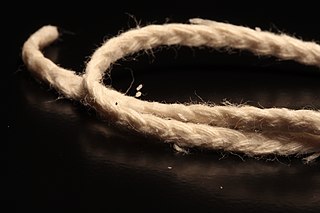
A candle wick is usually a braided cotton that holds the flame of an oil lamp or candle. A candle wick works by capillary action, conveying ("wicking") the fuel to the flame. When the liquid fuel, typically melted candle wax, reaches the flame it then vaporizes and combusts. The candle wick influences how the candle burns. Important characteristics of the wick include diameter, stiffness, fire-resistance, and tethering.

A kerosene heater, also known as a paraffin heater, is typically a portable, unvented, kerosene-fueled, space heating device. In Japan and other countries, they are a primary source of home heat. In the United States and Australia, they are a supplemental heat or a source of emergency heat during a power outage. Most kerosene heaters produce between 3.3 and 6.8 kilowatts.
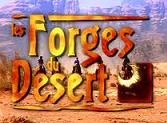
The Desert Forges was a game show set in the Wadi Rum desert region in Jordan. It was first aired on Channel 5 from 23 June to 25 August 2001. It is based on a French format called Les Forges du Désert, created by Pierre Sportolaro in 1999 and produced by Adventure Line Productions, also producers of Fort Boyard.
Also known as a "perfume lamp", "effusion lamp," or "catalytic lamp", a fragrance lamp is a lamp that disperses scented alcohol using a catalytic combustion wick consisting of a cotton wick threaded through a natural, porous stone. The catalytic combustion wick was developed and patented by Maurice Berger, a French pharmaceutical dispenser, in 1898 as a means of purifying the air in hospitals and mortuaries. It is claimed that this catalytic oxidation process destroys bacteria in the air and increases oxygen levels.

Oil well fires are oil or gas wells that have caught on fire and burn. They can be the result of accidents, arson, or natural events, such as lightning. They can exist on a small scale, such as an oil field spill catching fire, or on a huge scale, as in geyser-like jets of flames from ignited high pressure wells. A frequent cause of a well fire is a high-pressure blowout during drilling operations.

Altar candles are candles set on or near altars for religious ceremonies. Various denominations have regulations or traditions regarding the number and type of candles used, and when they are lit or extinguished during the services.
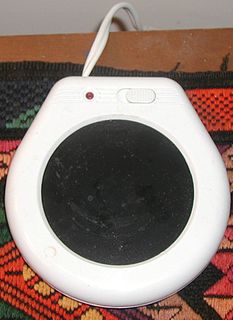
A candle warmer is an electric warmer that melts a candle or scented wax to release its scent. The candle warmer shown is intended to be used with jar candles or candles in cups, not with taper candles or candles without containers large enough to accommodate all the melted wax. Some candle warmers have a built-in bowl in which the candle is placed.

A link-boy was a boy who carried a flaming torch to light the way for pedestrians at night. Linkboys were common in London in the days before the introduction of gas lighting in the early to mid 19th century. The linkboy's fee was commonly one farthing, and the torch was often made from burning pitch and tow.
Lamp trimmer was a specialist position onboard ships that involved maintaining oil lamps.

Condensed aerosol fire suppression is a particle-based form of fire extinction. It is similar to gaseous fire suppression.
















